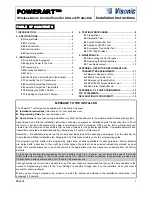
6
DE5458
Following are two examples of good earth connections (applicable in the U.S.A. only):
Cold-water metal pipe:
Connect the earth wire to the pipe, using a non-corrosive metal strap (preferably copper), firmly
secured to the pipe.
AC Power outlet ground
: This ground is available in 3-prong, 120 VAC outlets. Test the validity of the ground terminal
with a 3-wire circuit tester that has neon lamp indicators (UL Listed Ideal Model 61-035 or equivalent, available from
electrical supply stores).
For telephone type connectors, you will need these items:
•
A length of 6-lead, color coded modular cable.
•
An length of 8-lead, color coded modular cable.
•
Two 6-position RJ-11 plugs and one 8-position RJ-31X
plug, to terminate the cables at the PowerArt™ end.
•
Crimping tools for RJ-11 and RJ-31X plugs.
Refer to Figure 10 and proceed as follows:
A .
Extract the screw terminal blocks one by one and make
the necessary connections. When done, plug each
terminal block onto its PCB mounted pins.
B.
Prepare the cable assemblies that connect the:
"
Powerline carrier (X-10) socket to the Powerline
interface module (make sure it is “1 to 1”).
"
The LINE socket to the telephone line (or the LINE
& SET socket to the line and local telephone set).
C.
Mate the RJ-11 and RJ-31X plugs with their respective
jacks. Do not confuse the X-10 plug with the LINE plug.
D.
Route the wires via the wiring channels at the back.
With all wires properly seated, proceed to Para. 3.6.
3.6 Cabinet-to-Bracket Attachment
Once all connections are made and the wires are seated
within the channels at the rear, it is only necessary to
attach the control panel to the wall-mounted bracket.
Having separated the bracket from the cabinet (see Para.
3.4.), you already have a notion of what is to be done.
Nevertheless, refer to Figure 11 and proceed as follows:
A.
Hold the cabinet with its top slightly slanted toward
yourself and align the trap at the bottom of the cabinet
with the dual-prong catch at the bottom of the bracket.
Figure 11.
Cabinet-to-Bracket Assembly - Top View
B.
Allow the dual prong catch to enter the trap as far as it
will go while slanting the cabinet towards your stomach.
C.
Using the dual prong catch as a pivot, bring the top of
the cabinet closer to the wall, allowing the two hangers
to enter the two corresponding holes in the cabinet.
D.
Once the cabinet is flush against the bracket, slide it
down as far as the hangers will allow (about 10 mm).
The dual prong catch at the bottom should snap into
place with a click.
Figure 12.
Cabinet-to-Bracket Assembly - Side View
E.
Pry the left side cover loose and remove it as explained
in Para. 3.2, Steps A through C.
F .
You will find the bracket locking device in the open
position shown in Figure 13, part A.
G .
Make sure that the screw is loose enough to allow
shifting the lock down.
H .
Shift the lock down as shown by the arrow to reach the
position viewed in part B and tighten the screw.
A. OPEN
B. CLOSED
Figure 13.
Locking the Bracket
I.
Test the assembly by lightly pulling the cabinet away
from the wall. If correctly mounted, the cabinet will
adhere to the bracket.
Note:
See Para. 5.1 for dismounting procedure.
3.7 Connecting the AC Transformer
CAUTION! Do not plug the transformer into the AC
outlet before completing all other wiring.
A. U.S.A. only
: Remove the center screw from the AC
wall outlet.
B.
Plug the transformer directly in - the Power LED of the
control panel should illuminate.
C. U.S.A. only:
Use the screw removed in Step A above
to secure the transformer to the AC outlet. Tighten the
screw well.
D.
The distance of the transformer from the system should
not exceed 150 ft using 18 AWG conductors.
For UL installations, do not connect to a receptacle
controlled by a switch.
Содержание POWERART
Страница 15: ...DE5458 15 ...
















